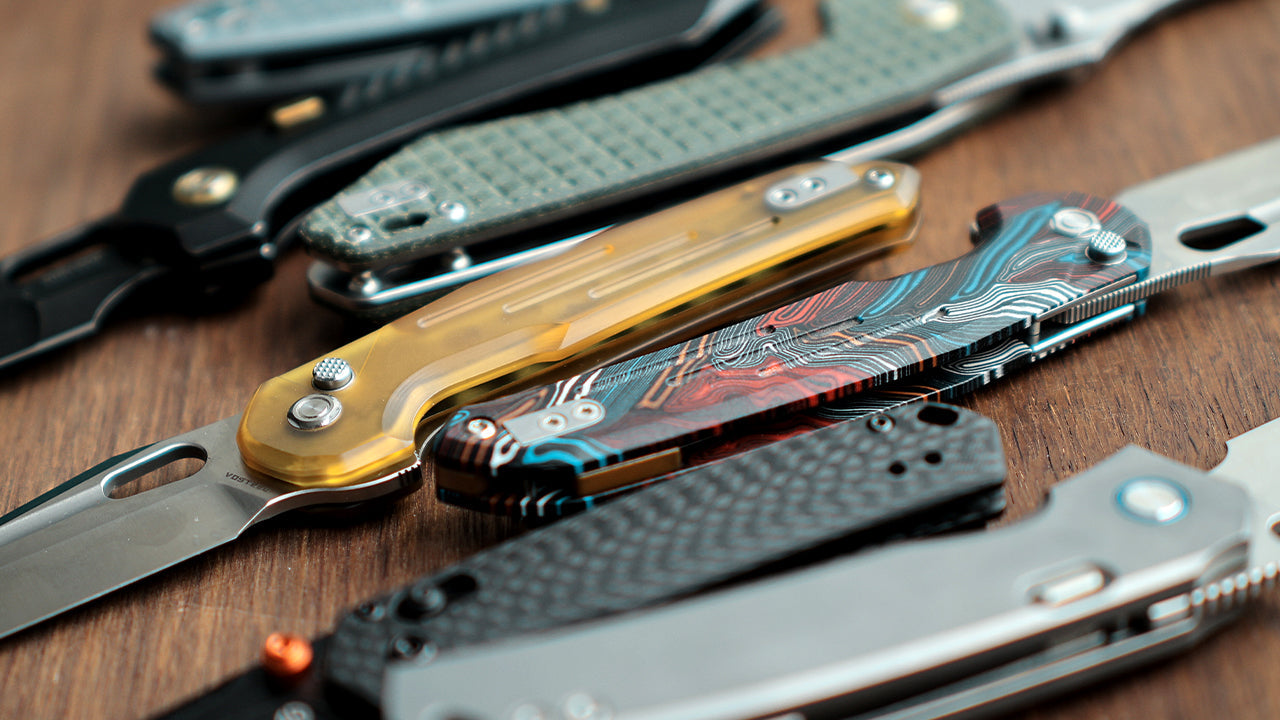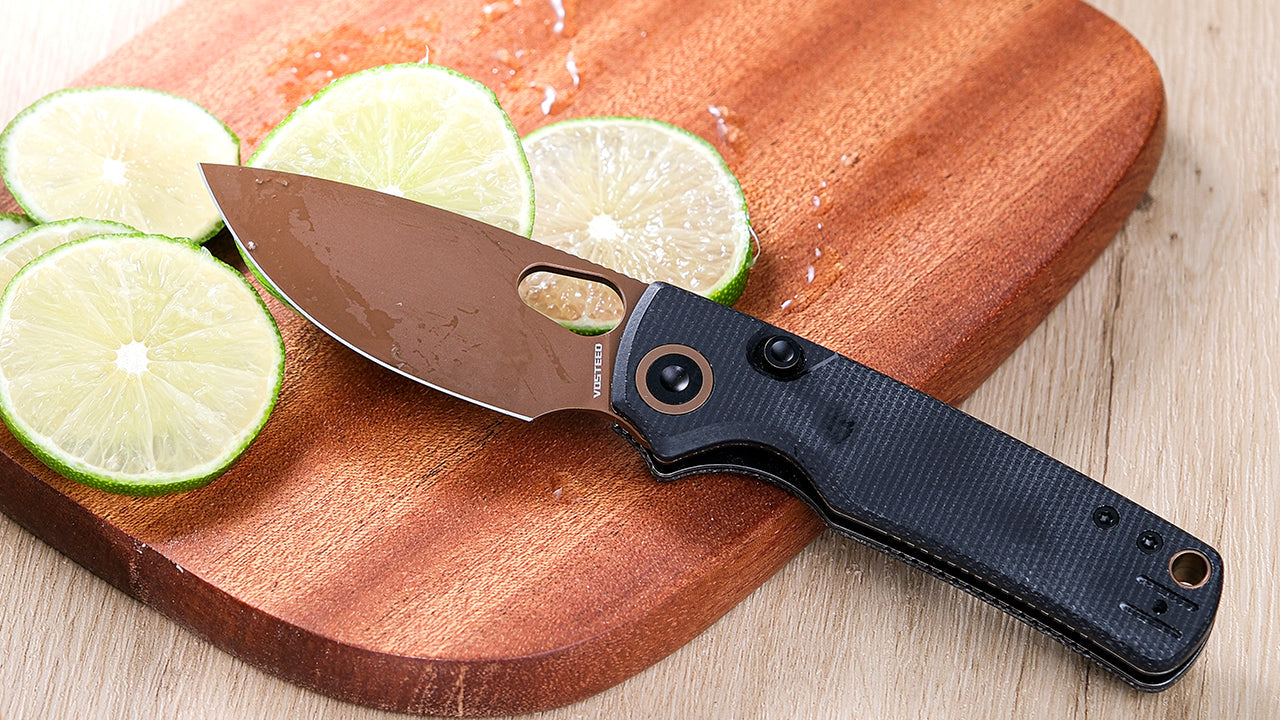The material of the handle—this unsung hero of knife design—is the critical link between intention and action in the world of high-end knives, imparting secrets of performance not found through specifications alone. The ideal handle turns what could otherwise be a mere tool into a seamless extension of your will and intention, converting every infinitesimal movement into exact cutting coordination like a master conductor bringing a symphony to life.
The Significance of Knife Handle Material for Function and Comfort
Your knife handle material impacts function as a whole and isn't just for show. The ideal material provides exacting grip stability for controlled, precise use, and its thoughtfully crafted ergonomics are a joy to grasp for those long periods of time sometimes needed.
Good materials protect against the elements by withstanding shocks, fending off wetness, and being stable under severe temperatures.
High-quality handles also distribute evenly the weight so that the knife is an extension of your movement rather than a distinct tool.
Furthermore, high-quality materials are chemical and oil resistant, wear and tear resistant, and maintain performance and good looks even after years of excessive use.
Vosteed produces knives that are unique in appearance and function by thoughtfully choosing best-quality handle material to match our high-performance blades. Our passion for perfection makes every material selection upgrade your cutting experience while living up to the demanding requirements of repeated use.
Choose the Right Material for Pocket Knives and Fixed Blade Knives
Handle materials have varying requirements in fixed blade knives and pocket knives. Let's discuss the primary differences:
Pocket Knives:
-
Pocket knives require material that maintains dimensional stability when closed
- Benefit from lightweight material for easy pocket carry
- Require material that can withstand repeated opening and closing
- Typically include handle materials designed to work with lock mechanisms
Fixed Blade Knives:
- Fixed blade knives require hardy material that can withstand harsh outdoor use
- Benefit from ergonomic materials and designs that enhance grip under aggressive cutting
- Must withstand environmental factors like moisture, temperature fluctuations, and UV light
- Should provide optimal balance to the blade to enable ultimate control
What Makes an EDC Knife Handle Special?
Everyday Carry (EDC) knives have specific requirements for their handle material that set them apart:
- Lightweight yet tough construction for convenient daily carry
- Thin profile that doesn't create unwanted bulk in pockets
- Good grip that works well over a variety of conditions (e.g., light dampness)
- Protection from daily wear (keys, coins, and other pocket debris)
- Appealing looks that can survive office and everyday carry environments
Top 5 Knife Handle Materials: Complete Performance Comparison
G10 Knife Handles: All-around Material
G10 is one of the most popular handle materials worldwide, and for good reason. This high-pressure fiberglass laminate offers exceptional performance characteristics for a multitude of knife applications.Many EDC knives feature G10 handles due to their reliability in various conditions.

Benefits:
- Exceptional impact and durability resistance
- Excellent grip that can be easily textured in manufacturing
- Dimensional stability in a variety of environmental conditions
- Chemical and water resistance
- Available in a broad range of colors and designs
- Moderately light in weight relative to metal options
Drawbacks:
- Can be a bit "synthetic" compared to natural materials
- Can lack the upscale feel of carbon fiber or titanium
- Heavily textured G10 can be abrasive on clothing
Best Uses: G10 excels in everyday carry folders, and utility fixed blades. It's particularly well-suited for knives used in wet or damp environments where traction is required.
Carbon Fiber Handle Knives: Light and Resilient
Carbon fiber represents the best blend of high-tech performance and luxurious aesthetics, making it the preferred choice for serious knife users. Modern folding knives with carbon fiber handles are increasingly popular among collectors and professionals alike.
Popular Carbon Fiber Variants in EDC:
- Standard Twill Weave: Clean, woven checkerboard pattern
- Forged Carbon: Random, marbled pattern—very modern and unique
- Shred carbon fiber refers to composite material made from chopped or shredded pieces of carbon fiber, usually mixed with resin and compressed into a solid block or sheet
- Fat Carbon / Layered CF: Infused with colors (e.g., blue, gold, red) for custom looks.
Benefits:
- Extremely light build
- Superb strength-to-weight ratio
- Clean, high-tech appearance that suits modern designs
- Excellent chemical resistance
- Does not absorb water or other liquids
- Temperature-stable properties
Drawbacks:
- Typically more expensive than the majority of other handle materials
- Can be slightly brittle when struck from the side
- Typically smoother grip than textured G10
- Requires special care during manufacturing
Best Uses: Carbon fiber works best on high-end daily carry knives where reducing weight is crucial without sacrificing strength.

Titanium Blade Knife Handles: High-End
Titanium is the ultimate metal handle material, offering an unrivaled combination of strength, low weight, and corrosion resistance.
Benefits:
- Unrivaled strength-to-weight ratio compared to metals
- Almost immune to corrosion
- Can be anodized in numerous colors for customizing
- Natural antimicrobial action
- Good heat resistance
- Provides a solid, premium feel in the hand
Drawbacks:
- Can be slippery when not texturized
- Expensive compared to most other handle materials
- Conducts cold temperatures to the hand
Best Uses: Titanium knives is a standout in premium folding knives, particularly those with frame lock mechanisms whose handle material is integrated into the locking system.

Micarta Knife Handles: Grippy and Classic
Micarta is a resin-based composite made from layers of fabric, such as canvas or linen, bonded under pressure. It offers a warm, natural feel and is favored by both traditionalists and hard-use knife users.
Benefits:
- Excellent grip, especially when wet
- Warmer and softer in hand than synthetics like G10
- Aesthetic depth and vintage look, especially with canvas-based versions
- Lightweight and durable
- Ages well over time, developing unique character with use
Drawbacks:
- Can absorb moisture if not sealed properly
- Slightly less durable than carbon fiber or G10 under heavy impact
- Surface can wear down or polish smooth with long-term use
Best Uses: Micarta knives in bushcraft knives, outdoor fixed blades, and any tool where wet grip and comfort are priorities. It’s also popular among collectors for its old-school charm.
Aluminum Knife Handles: Lightweight and Durable
Aluminum handles are typically made from aircraft-grade alloys, anodized for added strength and appearance. This material strikes a balance between durability, weight, and affordability.
Benefits:
- Lightweight with good structural strength
- Resistant to corrosion when anodized
- Sleek, modern appearance
- Cost-effective compared to titanium
- Available in many colors and finishes
Drawbacks:
- Can feel cold or harsh in the hand
- May become slippery without added texture
- Scratches more easily than G10 or titanium
Best Uses: Aluminum knives is ideal for EDC folders, tactical knives, and automatic knives where weight and strength matter—but cost and styling are also important.
How to Choose the Best Handle Material for Your Knife
Selecting the right handle material for your knife isn't just about looks—it significantly impacts performance, comfort, and durability. Here’s what to consider when making your decision:
Firstly, Use: The handle material depends on how you'll use your knife. For outdoor pursuits, a G10 handle is an excellent choice—it’s grippy, tough, and weather-resistant. Rubber is also useful for wet conditions.
For safety and control, grip security is essential. Textured rubber, G10, and micarta handle materials provide better traction in wet or slippery circumstances. These materials keep your knife secure in damp settings and when handling food, reducing mishaps.
Environmental Concerns: Take into account your knife's environment. Stainless steel, rubber, or plastic handles resist corrosion, making them perfect for moist or humid settings. For knives used in severe temperatures, G10 or carbon fiber will remain durable.
Weight Trade-Offs: Comfort, especially for long use, depends on knife handle weight. Plastic and aluminum are lighter and simpler to handle, while wood and micarta are more balanced but heavy. The appropriate balance is key—too weighty and your knife may feel clunky; too light and it may lack strength or durability.
Aesthetics: Your knife handle is as much a fashion statement as a tool. sophisticated materials like G10, carbon fiber, and micarta are sleek and sophisticated, whereas wood is timeless. You'll use a material for its practicality and appearance, so choose one that matches your tastes and demands.
Maintenance Tips: Caring for Different Knife Handle Materials
Proper care ensures your knife handle functions and looks great for many years. Here's how to care for each material:
- G10 Handles: Clean with mild soap and water; clear debris with a soft-bristled brush.
- Carbon Fiber Handles: Wipe clean with a damp cloth; dry by blowing compressed air through seams to remove dust.
- Titanium Handles: Wash with mild soap and water; remove scratches with fine abrasives.
- Carbon Steel Handles: Keep dry at all times; apply protective oil regularly; remove any surface rust immediately with fine steel wool; store in a low-humidity environment.
5 Common Mistakes to Avoid When Choosing Knife Handle Materials
Avoid these common pitfalls when choosing a knife handle material:
- Prioritizing looks over function
- Disregarding grip needs
- Ignoring weight balance
- Overlooking durability needs
- Forgetting maintenance requirements
The best knife handle material strikes a perfect balance between performance, comfort, durability, and looks. Whether you choose G10, carbon fiber, titanium, or carbon steel, each has its advantages tailored to specific needs. At Vosteed, we select the finest handle materials for each knife model to ensure maximum performance for its intended use.





Leave a comment
All comments are moderated before being published.
This site is protected by hCaptcha and the hCaptcha Privacy Policy and Terms of Service apply.